Brambles (Rubus fruticosus)
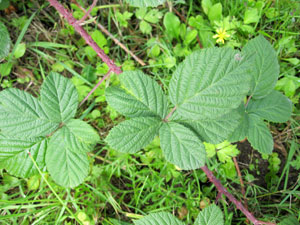
The bramble is a common native species. It is found in many different types of plant communities from woodlands, to heaths and dunes though it is not found in native pine woodland, and is generally more common in lowland than upland woods.
The bramble forms an underground, perennial rootstock that throws up new shoots in the Spring. These are have a two-year ‘life span’, i.e. they are biennial. In the first year, growth is vigorous and vegetative. If the tip of the shoot comes in contact with the soil then it may develop roots and form a daughter plant (this is a form of vegetative reproduction and plants formed in this way will have the same genetic make up as the parent plant). The leaves on these first year shoots are compound and palmate, with 5 – 7 leaflets. In the second year, lateral shoots develop which bear the flowers. The leaves on these lateral shoots are somewhat smaller, and have 3 – 5 leaflets.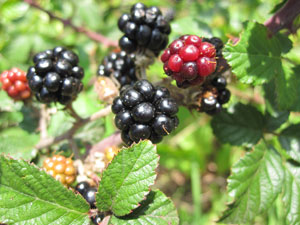
The flowers form in late spring / early summer and are white or pale pink. The fruit, the blackberry, develops from these flowers. However, some brambles produce fruit and seed without fertilisation – though the transfer of pollen to the stigmas of the flowers may be required as a stimulus for fruit and seed formation. This form of reproduction (which is neither truly asexual or sexual) is known as apomixis. Brambles and dandelions both make use of this method. Some brambles are also polyploid, that is, their chromosome number has doubled or trebled. As a result of apomixis, polyploidy and crossing, many microspecies of bramble have formed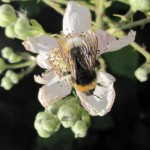 . These are quite difficult to identify, relying on minute differences in the flowering and non-flowering shoots, the leaves, the prickles and young fruits. Because of these many micro-species, the bramble is considered to be an aggregate species –and is written as Rubus fruticosus agg.
. These are quite difficult to identify, relying on minute differences in the flowering and non-flowering shoots, the leaves, the prickles and young fruits. Because of these many micro-species, the bramble is considered to be an aggregate species –and is written as Rubus fruticosus agg.
The fruit of the bramble is the blackberry, but in a strict botanical sense, the blackberry is not a berry. Each tiny juicy ‘blob’ on the blackberry represents a tiny fruit or drupelet, and there are many of them so it is an aggregate fruit (a drupe is a fruit that has a fleshy, outer part that surrounds a stone or seed; a drupelet is a tiny drupe). Blackberries have formed part of the human diet in Western Europe for thousands of years. Examination of ‘Haraldskaer woman’ indicated that blackberries formed part of her diet.
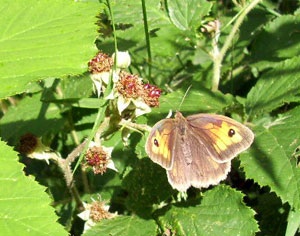 The bramble is a source of food for many species of insect and mite, with some species feeding exclusively on bramble. The bramble is also important to dormice, which eat their flowers and fruit ; they and other animals / birds seek refuge in bramble thickets. The leaves also represent a food source for deer, whose browsing may affect the development of bramble thicket. High numbers of deer can result in a reduction in the amount of bramble and consequently, the amount of wildlife in a given area.
The bramble is a source of food for many species of insect and mite, with some species feeding exclusively on bramble. The bramble is also important to dormice, which eat their flowers and fruit ; they and other animals / birds seek refuge in bramble thickets. The leaves also represent a food source for deer, whose browsing may affect the development of bramble thicket. High numbers of deer can result in a reduction in the amount of bramble and consequently, the amount of wildlife in a given area.
Large amounts of bramble can affect the microclimate of the ground / herb layer; influencing the growth and development of other plants. On one hand, it can offer protection from grazing / browsing (by deer / rabbits) to young tree seedlings but equally it can suppress the development of light loving species.
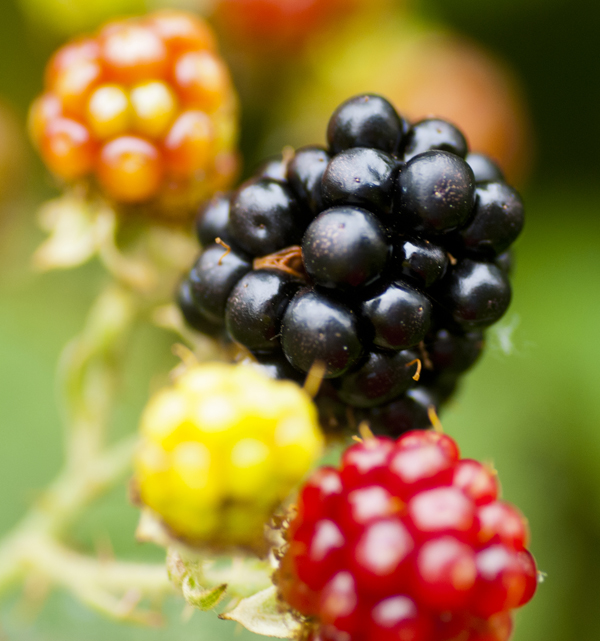
Comments are closed for this post.
Discussion
I would have thought you should be able to find a plant in the wild (nobody is going to miss one): dig it up carefully, plant it carefully, and stand well back!
Hi, I like the information on the lowly bramble but where can I buy it, all the normal online garden suppliers have only hybridised varieties, had them , dont like them, poor growth, strange shaped berries, not many fruit and poor taste in comparison to the wild bush.
Regards Richard

I’ve just ordered two wild blackberry bare root plants from Ashfield Trees.
They won’t be delivered until later in the year.
Valerie Allard
30 July, 2022